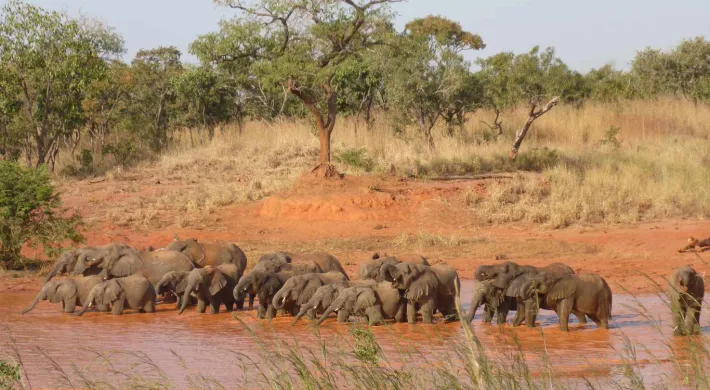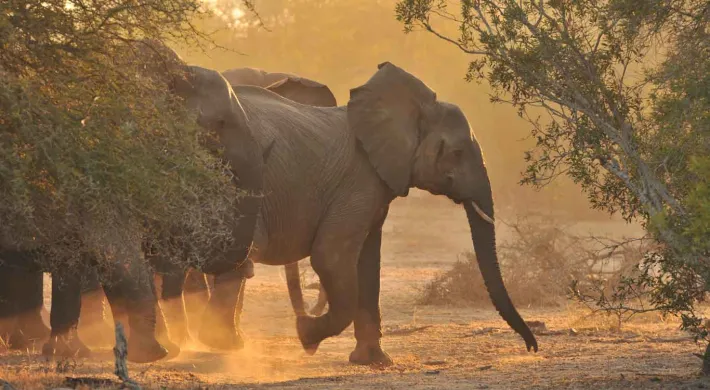Written by Mike Loomis, Chief Veterinarian Emeritus, North Carolina Zoo
The North Carolina Zoo began placing satellite telemetry collars on elephants in Cameroon in 1998. It took two years of preliminary work before the first collar was deployed.
In 1996, a team from the North Carolina Zoo met with Dr. Steve Gartland, the Country Director for WWF Cameroon (WWF-C). WWF-C was searching for technical assistance to establish an elephant monitoring program in the northern savannah region of Cameroon to combat human-elephant conflict and elephant poaching. Over the next two years, a Memorandum of Understanding (MOU) was negotiated between WWF-C and the Zoo, and letters of agreement were negotiated between the Cameroonian Ministry of Forests and Wildlife (MINFOF), which allowed the Zoo to import all equipment and drugs necessary to complete the project.
The MOU stated that the Zoo would provide veterinary expertise, purchase satellite telemetry collars, and pay for data transfer from the satellite system. WWF-C would provide all in-country expenses associated with the project. This became the model for Zoo's participation in elephant collaring programs in West and Central Africa.
The project's duration was originally set for three years, and the necessary funds were raised for the project by the North Carolina Zoological Society. The initial program was so successful that a steady stream of funding from various sources kept the program continuing until now and into the future. The program's focus has changed over the years to include collaring forest elephants and working in other countries. Our focus has been to develop techniques and procedures to collar elephants in low-resource settings with little to no infrastructure. Almost all of the elephants collared have been approached on foot from base camps set up in remote areas. We have never used airplanes or helicopters and very seldom used vehicles except to transport the team to trailheads.
Several milestones have been met over the life of the program.

The First Elephant
The first elephant collared was in Bouba Ndjida National Park in northeastern Cameroon in 1998. During this procedure, we tested equipment that we developed specifically to increase safety for elephants under anesthesia. Over the next several years, we successfully collared several elephants in the savanna regions of Cameroon. The data generated from the deployed collars have been successfully used to mitigate human-elephant conflict and combat elephant poaching.

The first elephant collared in Bouba Ndjida National Park, Cameroon by the North Carolina Zoo team
The First Forest Elephant
The success of our program in the savanna areas prompted WWF-C to request assistance with elephant monitoring in the forest areas of southeast Cameroon. Although human-elephant conflict is a problem in the forest, poaching is by far the most significant threat to elephants in this area. In addition, the government leased much of the forest area in SE Cameroon to logging companies.
The team found out very quickly that collaring elephants in the forest was significantly more difficult than collaring elephants in the savanna. Approaching elephants in dense vegetation to dart them was extremely difficult. Over a few unsuccessful attempts to dart forest elephants, the team developed strategies to approach elephants close enough to dart them without them being detected by the elephants. A local former elephant poacher named Desire, who was converted to conservation by WWF-C, was invaluable in teaching us how to approach elephants in the forest. Desire remains a member of our elephant collaring team.
The first elephant we successfully collared in the forest was a female in a small herd. She charged us several times after she was darted. We were able to get behind trees for safety. She eventually ran away from us. We followed the tracks until we found the elephant down at the edge of a river. We quickly approached the elephant and raised her trunk above the mud and water at the riverbank. The elephant was successfully collared, anesthesia reversed, and she ran off to join her herd. We subsequently collared several elephants in the forests of SE Cameroon. The data generated has been successfully used to improve the efficacy of anti-poaching patrols, leading to the arrest of numerous poachers and the destruction of poaching camps.
WWF-C has also used the data to negotiate sustainable logging agreements with several logging concessions to take elephant hot spots and corridors into consideration in their logging practices. As a side project in the forests of SE Cameroon, we also collared the first bongo (large forest antelope) to ever be collared in the wild.

The first forest elephant collared by the North Carolina Zoo team in Ndangaye Bai, Lobeke

The first-ever bongo collared in the wild in SE Cameroon.
The First Elephant on Mt. Cameroon
Mt. Cameroon is an active volcano on the west coast of Cameroon that rises from sea level to over 4000 meters. It is home to several endemic species as well as a population of chimpanzees and elephants. The government of Cameroon, recognizing the biological importance of Mt. Cameroon, decided to establish a new national park on Mt Cameroon.
Before establishing the boundaries of the new park, the government wanted to understand how elephants use the area to ensure that elephant hot spots and corridors were included in the boundaries of the park. Our long-term partner, WWF-C, asked for our assistance in attempting to collar elephants on Mt. Cameroon to evaluate the elephant's land use in the landscape.
Just as collaring elephants in the lowland rain forest was much more difficult than collaring elephants in the savanna, collaring elephants in the coastal mountain forests of SW Cameroon proved to be even a greater challenge. Even our funding partners (the German Development Bank), MINFOF, and WWF-C were skeptical that we would succeed due to the difficult terrain and the low elephant density. All of our equipment had to be carried to a base camp about 2000 meters from where we worked. Surface water was very limited on Mt. Cameroon in the dry season. We used this to our advantage and set up an ambush at a crater lake, an important dry season water source for elephants.
Our strategy worked, and we were able to collar an elephant in a very short period of time, much to the surprise of everyone involved. We ultimately collared five elephants on Mt. Cameroon. The data generated resulted in establishing a core protected area that included all important elephant habitats in the newly established Mt. Cameroon National Park.
Pictured Below: First elephant collared in Mt. Cameroon by North Carolina Zoo team.

The First Elephant in Nigeria
We were asked by another conservation partner, the Wildlife Conservation Society (WCS), to assist with collaring elephants in Yankari Reserve in Nigeria. Yankari contains the last viable population of savanna elephants in Nigeria and is surrounded by agricultural development. This was back to working in the savanna, which was much easier than working on Mt. Cameroon. The problems faced by elephants in Yankari were poaching and human-elephant conflict.
The first elephant we collared in Yankari was actually the first elephant to be collared in Nigeria, and we ended up collaring two elephants in Yankari. The data generated were used by the reserve rangers primarily to mitigate human-elephant conflict. The daily elephant locations were used to know when elephants left the reserve for agricultural areas so rangers could chase the elephants back into the reserve to limit agricultural damage from the elephants.

First elephant collared in Nigeria by the North Carolina Zoo team & the first elephant ever collared in Nigeria!
Côte d'Ivoire
Our current elephant collaring efforts are centered in Côte d'Ivoire in West Africa. Our successes in collaring both savanna and forest elephants in other countries led the Director of Wildlife of Côte d'Ivoire to request our assistance in collaring elephants. Issues faced in Côte d'Ivoire include significant loss of elephant habitat to agriculture, poaching, and human-elephant conflict. The elephant is the national symbol of Côte d'Ivoire, which added an additional sense of urgency. The program's goals are to mitigate human-elephant conflict, reduce poaching, understand elephant movement in the country, including transboundary migration and protect the remaining elephant populations in Côte d'Ivoire. We have negotiated a MOU with the Ministry of Water and Forests (MINEF) to provide assistance for five years. We used the same model for the MOU that we originally developed with WWF-C. We currently have four active collars deployed in Côte d'Ivoire.
You can read more about our work with elephants here or learn more about our fieldwork in Côte d'Ivoire in this blog, where our Director of Animal Health, Dr. Jb Minter, describes what it's like to track, dart, and collar and elephant. And make sure you come back soon for more information on our elephant collaring work!
Pictured Below: First elephant collared by the North Carolina Zoo team in Côte d'Ivoire





